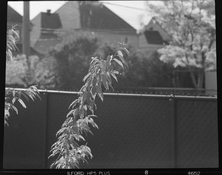I was doing some test shots the other day to fix a focusing issue with a camera (Rapid Omega 100), and I decided to mix from scratch a litre batch of Kodak D-61a to process my HP5+ (6x7 120).
It's the kind of developer that nobody seems to care about these days, mainly because it's a classic middle-of-the-road MQ thing. Call me boring, but the simplicity of old MQ formulas has always appealed to me, because they guarantee that you won't need to hunt after exotic ingredients to mix a batch, and you're not dependent on a single manufacturer like proprietary formulas.
Using sodium carbonate mono as alkali, it's fairly active, and Kodak recommends using it 1:3 for tank development. They give times around 12 mins in the J-1 publication, but that's way too much. Instead of fussing about with development times, I inferred from Kodak literature that development times for D-61a are almost equal to, maybe a hair shorter, than DK-50. Since I experimented quite a lot with DK-50 1:1 on HP5+ until I found my sweet spot, I just used the same time (5:15, inversions every 30 secs) with D-61a 1:3.
I'm glad to report that the results are very encouraging, at least based on the negatives alone. It's sharp, not too contrasty, not too grainy, and the contrast is looking normal. Bear in mind that these are just digicam shots of the negatives on a light table, but from direct evidence I can see I'm really in the same ballpark as DK-50 1:1.
The other reason why I wanted to try it, is that it is a replenishable developer, even in its dilute form, like DK-50 1:1. The stock solution of these developers is way too active (I suppose older films reacted differently), but since I have maintained a DK-50 1:1 batch for almost a year now, I'm confident that D-61a 1:3 will be fun to maintain as well.
There is an equivalent formula from Agfa, developer 47, which is used stock, is replenishable, and ends up the same as D-61a 1:1. Only Kodak gives the formula for a 1:3 replenisher.
Kodak D-61a
For tank use, dilute 1 part of stock solution with 3 parts of water.
Add stock solution (diluted 1:3) at intervals to maintain the volume, or use the replenisher, KODAK Replenisher D-61R, to maintain the strength of the tank solution.
Kodak replenisher D-61R
Stock Solution A
Stock Solution B
To Use: Take 3 parts of Stock Solution A and 1 part of Stock Solution B, and add to the tank dilution of developer as needed. Do not mix Solutions A and B until you are ready to use them.
It's the kind of developer that nobody seems to care about these days, mainly because it's a classic middle-of-the-road MQ thing. Call me boring, but the simplicity of old MQ formulas has always appealed to me, because they guarantee that you won't need to hunt after exotic ingredients to mix a batch, and you're not dependent on a single manufacturer like proprietary formulas.
Using sodium carbonate mono as alkali, it's fairly active, and Kodak recommends using it 1:3 for tank development. They give times around 12 mins in the J-1 publication, but that's way too much. Instead of fussing about with development times, I inferred from Kodak literature that development times for D-61a are almost equal to, maybe a hair shorter, than DK-50. Since I experimented quite a lot with DK-50 1:1 on HP5+ until I found my sweet spot, I just used the same time (5:15, inversions every 30 secs) with D-61a 1:3.
I'm glad to report that the results are very encouraging, at least based on the negatives alone. It's sharp, not too contrasty, not too grainy, and the contrast is looking normal. Bear in mind that these are just digicam shots of the negatives on a light table, but from direct evidence I can see I'm really in the same ballpark as DK-50 1:1.
The other reason why I wanted to try it, is that it is a replenishable developer, even in its dilute form, like DK-50 1:1. The stock solution of these developers is way too active (I suppose older films reacted differently), but since I have maintained a DK-50 1:1 batch for almost a year now, I'm confident that D-61a 1:3 will be fun to maintain as well.
There is an equivalent formula from Agfa, developer 47, which is used stock, is replenishable, and ends up the same as D-61a 1:1. Only Kodak gives the formula for a 1:3 replenisher.
Kodak D-61a
| Water, about 50° C (125° F) | 500 milliliters |
| Metol | 3.0 grams |
| Sodium Sulfite (Anhydrous) | 90.0 grams |
| Sodium Bisulfite (Anhydrous) | 2.0 grams |
| Hydroquinone | 6.0 grams |
| Sodium Carbonate (Monohydrated) | 14.0 grams |
| Potassium Bromide (Anhydrous) | 2.0 grams |
| Cold water to make | 1.0 liter |
For tank use, dilute 1 part of stock solution with 3 parts of water.
Add stock solution (diluted 1:3) at intervals to maintain the volume, or use the replenisher, KODAK Replenisher D-61R, to maintain the strength of the tank solution.
Kodak replenisher D-61R
Stock Solution A
| Water, about 50° C (125° F) | 3.0 liters |
| Metol | 6.0 grams |
| Sodium Sulfite (Anhydrous) | 180.0 grams |
| Sodium Bisulfite (Anhydrous) | 4.0 grams |
| Hydroquinone | 12.0 grams |
| Potassium Bromide (Anhydrous) | 3.0 grams |
| Cold water to make | 6.0 liters |
Stock Solution B
| Sodium Carbonate (Monohydrated) | 280.0 grams |
| Water to make | 2.0 liters |
To Use: Take 3 parts of Stock Solution A and 1 part of Stock Solution B, and add to the tank dilution of developer as needed. Do not mix Solutions A and B until you are ready to use them.








